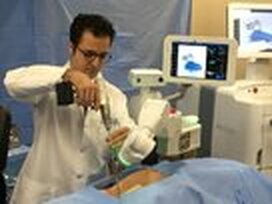Medtronic Mazor X robotic surgery system enters medical mainstreamAbbott Northwestern, Mayo are among the hospitals using the new Medtronic technology.
By Joe Carlson Star Tribune
FEBRUARY 26, 2019 — 7:14PM
Spine surgeon Dr. Eiman Shafa demonstrated at Abbott Northwestern Hospital on Tuesday how the new system uses robotics and in-room navigation to precisely position traditional surgical tools, making routine spine cases more efficient and complex cases more exacting. The Mayo Clinic in Rochester also has such a system.
We’re basically performing the same surgeries that we have in the past … [but] this device helps us to do that with overall less collateral damage,” said Shafa, who works for the Twin Cities Spine Center and uses Medtronic’s Mazor X system at Abbott Northwestern in south Minneapolis. “In essence, it allows us to be as less-invasive as we can possibly be.”
Like other kinds of robotic surgical systems, the Mazor X is a piece of durable hospital equipment that also requires single-use items for each procedure. Medtronic acquired the device’s original maker, Israel-based Mazor Robotics, in a $1.8 billion deal in December.
The Mazor X retails for less than $1 million to hospitals, though Medtronic is hoping the system will drive not just sales of robots, but a long list of Medtronic supplies used in spine surgery — especially as traction grows for the latest model, the Mazor X Stealth Edition, which incorporates Medtronic engineering and design into Mazor’s existing system.
“We believe that integrating the Mazor X robot with our StealthStation navigation and O-arm imaging equipment, as well as with our spine implants, creates a long-term competitive advantage for us in the spine market; one that we intend to capitalize on,” Medtronic Chief Executive Omar Ishrak told stock analysts in November, according to a transcript from Seeking Alpha.
Medtronic announced the U.S. launch of the Stealth Edition in January. The system that Shafa demonstrated on Tuesday was the older Mazor X version, though a spokesman for Abbott Northwestern said the hospital’s system is slated to be upgraded to the latest Stealth Edition by early April.
With television cameras rolling in a small conference room on the ground floor of Abbott Northwestern, Shafa showed how the Mazor X’s robotic arm could execute a previously programmed surgical plan using a mannequin. (Although the mannequin had a large section of its “back” removed for the demo, a real lumbar-fusion surgery with the system would have been done “percutaneously” using thin instruments and small tunnels through muscle.)
Once Shafa was ready, the robotic arm emitted green light and a faint alert tone as the robotic arm swung into the surgical field above the mannequin. Using navigation data beamed from a component with dual side-by-side sensors that look a bit like the head of an old Nintendo “Robotic Operating Buddy,” the device positioned a tool holder at the correct height and angle above the “patient” so that Shafa could direct a guidewire and manual bone drill into position.
“As you can see, the steps are fluid. They are reproduceable. This allows me extra efficiency in the operating room. And a goal of having a shorter operation,” Shafa explained as he worked. “That means less blood loss, and hopefully a less painful surgery.”
Jean Pearson, 58, of Coon Rapids, said she was surprised to learn that her surgery six weeks ago would be done using robotic guidance, but she was ready to try it.
On Tuesday, she stood under her own power at the front of the room next to Shafa, who explained that Pearson needed surgery to treat a complex, multiple-level deformity that required putting screws into Shafa’s very narrow “pedicles,” which are bony structures on the vertebrae.
“It’s going really well,” Pearson said Tuesday. “I’m amazed to be standing here.”
Joe Carlson writes about medical technology in Minnesota for the Star Tribune.
[email protected] 612-673-4779 _JoeCarlson



 RSS Feed
RSS Feed